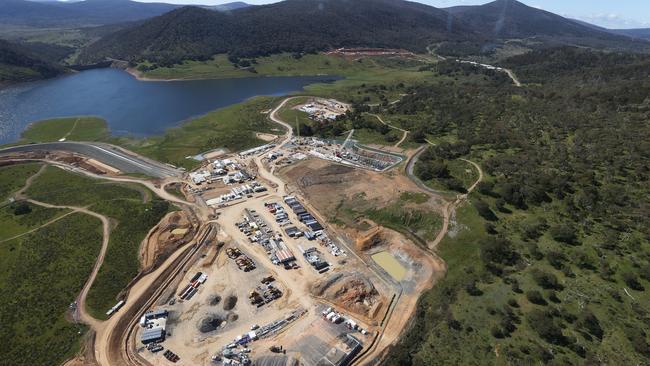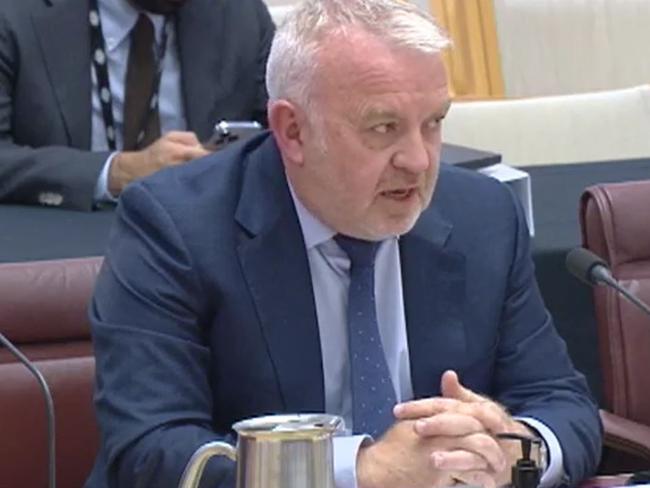Go slow: Snowy Hydro’s Florence tunnelling at snail’s pace
Snowy Hydro may acquire a fourth tunnel boring machine to ensure Snowy 2.0 dodges further delays at the nation’s biggest renewable energy project.

The federal government-owned Snowy Hydro may acquire a fourth tunnel boring machine to ensure Snowy 2.0 dodges further delays, after the energy operator warned challenging ground conditions could hamper progress on the nation’s biggest renewable energy project.
Snowy 2.0 suffered a series of problems last year, including the giant tunnel boring machine, known as Florence, getting stuck underground after becoming bogged in soft ground, forcing work to stop.
Snowy revealed on Monday that Florence had completed less than 250m of work at the under-construction hydro scheme since it resumed drilling in December.
The revelation will heighten concern about the giant hydro development, which is widely seen as critical for Australia’s energy transition this decade.
Snowy Hydro chief executive Dennis Barnes told Senate estimates one option under consideration would be an acquisition of a fourth tunnel boring machine.

Mr Barnes said buying such a machine would not increase the total cost of the project, with significant contingency funds already baked in. However, with the cost of building Snowy 2.0 already doubling to $12bn, the prospect of further challenging ground conditions may stoke further concern around delivery of the project.
“Tunnel Boring Machine Florence recommenced tunnelling late last year following approval from the NSW Department of Planning and Environment,” Mr Barnes said.
“As of today she has tunnelled 241m and tunnelling in open mode. We are mindful some of the ground conditions ahead of Florence will be challenging and we continue to closely examine options to derisk this.”
Mr Barnes said there remained parts – most notably several years off – when ground conditions would once again sour.
The 2000-megawatt expansion of the pumped hydro storage project in NSW has been beset by problems that has forced prolonged delays and swelled the taxpayer bill.
Snowy was initially projected to cost about $2bn and be completed in 2021, before being revised to almost $6bn. It is now expected to cost $12bn.

Mr Barnes said Florence would need to tunnel 15km to complete one of the most vital parts of the project, which would require progress of about 15m a day.
He said there had been days since the machine restarted when work had hit that target, but others when the milestone had been missed.
The sluggish progress – albeit with difficult conditions – will heighten concerns about the project’s timetable of generating first power by 2027 and starting commercial operations in December 2028.
Still, Mr Barnes said the infrastructure project was on course.
Snowy has encountered unexpected geological issues, which has stoked alarm that it may not be completed as scheduled. But Australia is increasingly reliant on the development of the renewable project as a string of coal generators are forced into retirement as they reach the end of their lifespan.
Labor has set an aggressive energy transition target of having renewable energy generate 82 per cent of Australia’s electricity by 2030. Developers are moving quickly to develop renewable energy generation projects, but Australia’s rollout of so-called back-up storage such as Snowy 2.0 is well behind the pace.

Such is the concern, the Australian Energy Market Operator has warned that the country faces a decade of unreliable electricity supplies unless there is a significant increase in development, particularly firming capacity.
Coal is the dominant source of electricity in Australia, accounting for nearly two-thirds of generation throughout a typical day – and it plays a vital role in backing up renewable generation during peak demand periods when there is unfavourable weather.
AEMO now expects Australia’s coal power generation fleet to have been retired in the next decade, increasing the pressure on Snowy 2.0 to be ready on time.
By 2028, EnergyAustralia’s Yallourn coal power station – Victoria’s biggest electricity generator – will retire, while Origin Energy’s Eraring coal power plant in NSW will probably have been mothballed for years by then.
To replace coal, Australia will need a substantial increase in firming capacity.
Batteries are a possible solution, but they do not have the scale of Snowy Hydro 2.0, which is so large that once complete it will be able to provide enough electricity to run large swathes of the grid on its own for about a week.
Australia cannot easily build alternative pumped hydro projects, with few available sites available – even less with the scale of Snowy Hydro. Without Snowy, Australia could face electricity price volatility.
The nation has some of the highest power bills in the world, and the government has said it can drive the transition and deliver bill relief.
But voters have been left angry after two years of price increases of more than 20 per cent.
nowy Hydro revealed on Monday that Florence had completed less than 250m of work at the under-construction hydro scheme since it resumed drilling in December. Picture: Four Corners






To join the conversation, please log in. Don't have an account? Register
Join the conversation, you are commenting as Logout